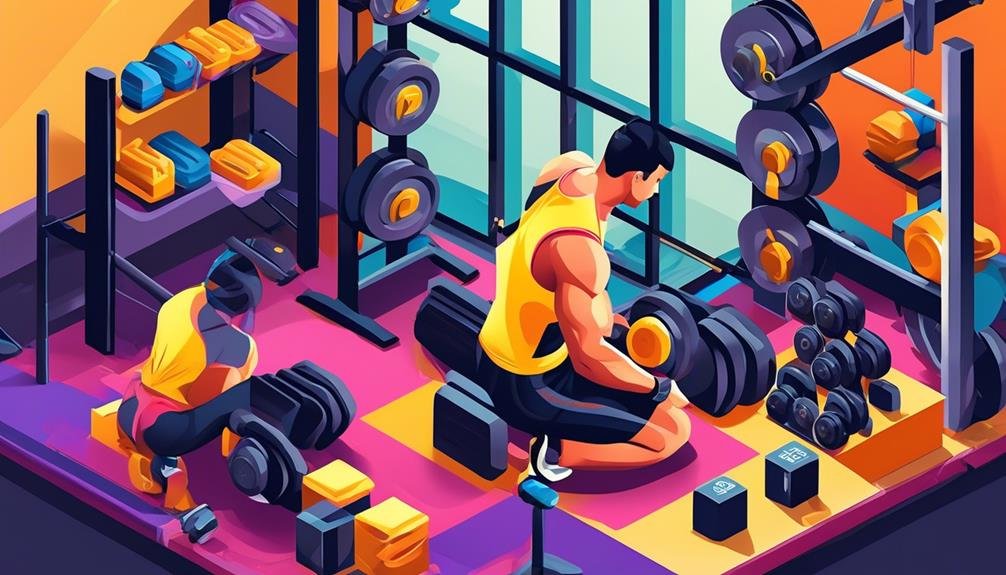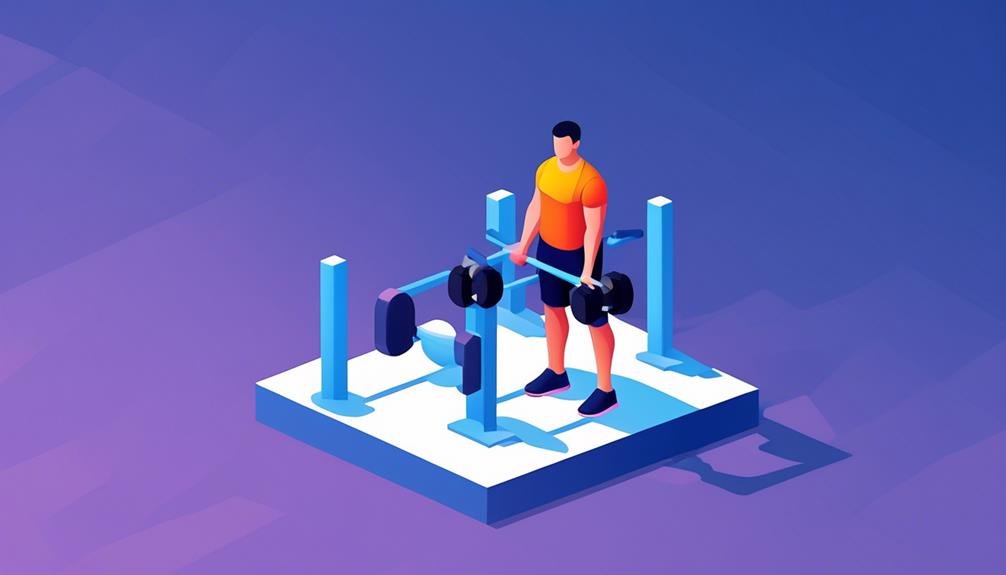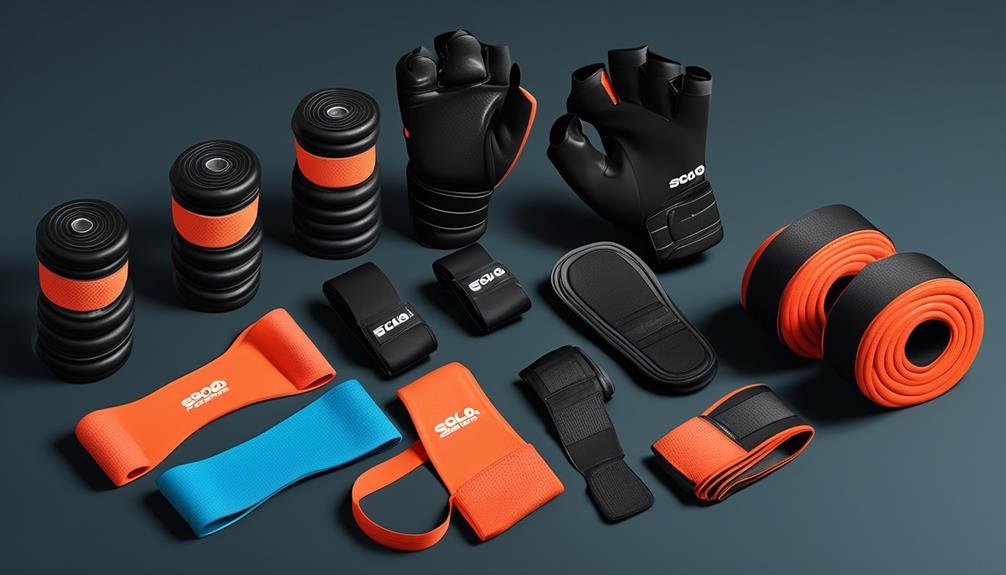You step into the weight room, the clanking of metal and the scent of sweat filling the air. As you approach the machines and weights, you can't help but feel a rush of excitement. But before you dive into your workout, it's important to prioritize your safety.
In this discussion, we will explore the essential precautions you should take when working out alone with weights or machines. From proper warm-up techniques to using correct form and posture, we'll cover it all.
So, buckle up and get ready to take your fitness journey to the next level while keeping yourself safe and injury-free.
Key Takeaways
- Gradually increase weight or resistance levels to maintain proper form and technique.
- Use a spotter when necessary, especially for heavy lifts, to ensure safety and receive feedback.
- Maintain proper form and posture by aligning the body correctly and avoiding arching or rounding the back.
- Incorporate warm-up and cool-down routines into workouts to reduce the risk of injury and improve muscle performance.
Proper Warm-up and Cool-down
Before you begin your workout, it's crucial to properly warm up and cool down to prevent injuries and optimize your performance.
Warming up prepares your body for the upcoming physical activity by gradually increasing your heart rate and blood flow. Engaging in dynamic stretches, such as leg swings or arm circles, helps to loosen up your muscles and enhance joint flexibility. This not only reduces the risk of injury but also improves your muscle performance during the workout.
After completing your workout, it's equally important to cool down and allow your body to recover. Cooling down helps regulate blood flow and prevents muscle stiffness. One effective way to cool down is by performing static stretches, focusing on the muscles you targeted during your workout. These stretches should be done when your muscles are warm, as it aids in recovery and reduces the risk of injury.
To ensure your safety during warm-up and cool-down, it's essential to follow proper form and safety guidelines. Take your time to gradually increase the intensity of your warm-up and cool-down exercises. By doing so, you reduce your risk of injury and allow your body to adjust to the physical demands of the workout.
Use Correct Technique
To prevent injuries while lifting weights or using machines, it's crucial to focus on using correct form and technique. Proper form not only maximizes the effectiveness of your workout but also reduces the risk of injury.
Here are some key points to keep in mind when it comes to using correct technique:
- Ensure proper body positioning and posture: Maintain a neutral spine, engage your core, and keep your shoulders back and down. This helps to minimize the risk of strain or injury to your back, neck, and shoulders.
- Use a controlled and steady movement pattern: Avoid jerking or swinging the weights. Instead, lift and lower them in a controlled manner, using the targeted muscles. This helps to protect your joints and prevents strains and sprains.
- Avoid using momentum: It's important to rely on your muscles, not momentum, to lift weights. This ensures that you're effectively targeting the intended muscles and reduces the risk of injury.
Start With Appropriate Weight or Resistance

Maintaining proper form and technique is essential for a safe workout. When working out alone in your home gym, it's crucial to use lighter weights or resistance levels that allow you to perform exercises with proper form and technique. Using weights that are too heavy can lead to strain, injury, or compromise your form, putting you at risk.
To ensure a safe and effective workout, it's advisable to gradually increase the weight or resistance as you build strength and confidence in your abilities. Start with a weight or resistance level that challenges you but still allows you to maintain proper form. Listening to your body is key, so if the weight feels too heavy or you can't perform the exercise correctly, it's important to adjust accordingly.
Seeking guidance from a fitness professional can also help you determine the appropriate starting weight or resistance for your fitness level. They can provide valuable insights and ensure that you're using the right amount of weight to avoid injury and maximize your results.
Use a Spotter When Necessary
Using a spotter is crucial for ensuring safety and preventing injuries when attempting heavy lifts or exercises that involve being under the bar. Whether you're working out at home or in the gym, having a spotter can make a significant difference in your training plan. Here are some reasons why using a spotter is necessary:
- Assistance with heavy lifts: A spotter can provide assistance in case of a failed lift, helping you avoid potential injuries. They can help you safely rack the weight or provide just enough assistance to complete the rep.
- Maintaining proper form: Having a spotter ensures that you maintain proper form throughout your exercises. They can provide feedback and make corrections, helping you avoid any potential injuries caused by improper technique.
- Safety during challenging exercises: Exercises like dumbbell bench presses and overhead barbell presses require you to be under the bar. Having a spotter ensures that you have someone to assist you in case you struggle or need to bail out safely.
When training alone without a spotter, it's important to consider alternative exercises or equipment that prioritize safety. Minimizing the risk of injury should always be a top priority when working out alone with weights or exercise equipment.
Maintain Proper Form and Posture

When working out alone with weights or machines, it's crucial to maintain proper form and posture to prevent strain and injury. Proper form and posture are essential elements of strength training and weight training, as they help ensure that you're targeting the correct muscles and minimizing the risk of injury.
To maintain proper form and posture, always make sure that your body is aligned correctly and your movements are controlled and deliberate. Keep your spine in a neutral position, engage your core, and avoid arching or rounding your back during exercises. Pay attention to your body positioning and joint alignment to prevent unnecessary stress on your muscles and joints.
If you're unsure about the correct form for a particular exercise, it's always a good idea to seek guidance from a fitness professional, such as a personal trainer. They can help you understand the correct form and posture for each exercise, and provide you with valuable feedback to ensure that you're performing the exercises safely and effectively.
Stay Hydrated and Take Rest Breaks
To ensure your safety and well-being during your solo workout sessions with weights or machines, it's important to prioritize staying hydrated and taking regular rest breaks. Here are some key points to keep in mind:
- Stay safe by staying hydrated: Drinking water before, during, and after your workout is crucial to maintain hydration. Dehydration can lead to decreased performance, muscle cramps, and even fainting. Keep a water bottle nearby and take sips of water throughout your workout to replenish fluids.
- Prepare your body with rest breaks: Overexertion can lead to injuries and fatigue. Take regular rest breaks to give your body time to recover and prevent pushing yourself too hard. Listen to your body's signals for fatigue and take breaks accordingly.
- Train to failure isn't the number one goal: While challenging yourself is important, training to failure every time may increase the risk of injury. Push yourself, but also know your limits. It's better to gradually increase intensity over time rather than going all out from the start.
Staying hydrated and taking rest breaks may seem simple, but they go a long way in ensuring a safe and effective workout. Make them a top priority and watch your performance improve while keeping yourself healthy and injury-free.
Use Safety Equipment, Such as Gloves or Wrist Wraps

Consider using safety equipment, such as gloves or wrist wraps, to protect your hands and wrists during your weightlifting or machine workouts. Safety equipment is an essential part of any workout routine, as it helps prevent accidents and injuries that could derail your progress.
When lifting weights or using machines, it's important to make sure you have the proper gear to keep yourself safe. Gloves provide a layer of protection for your hands, reducing the risk of blisters, calluses, and other injuries. Wrist wraps, on the other hand, offer support to your wrists, which can be particularly beneficial when lifting heavy weights.
These safety precautions are especially important if you have any pre-existing conditions, such as heart disease, or if you're new to weightlifting. Remember, it's always a good idea to seek medical advice before starting any new exercise regimen.
Listen to Your Body and Stop if You Feel Pain or Discomfort
Pay attention to your body's signals and immediately stop your workout if you experience any pain or discomfort. This is crucial for staying safe while working out alone with weights or machines. Pushing through pain can cause injury and setbacks in your fitness journey. To avoid this, listen to your body and respond accordingly.
Here's why:
- Pain or discomfort may indicate an injury or strain, so it's essential to stop and assess the situation. Ignoring these signals can worsen the problem and prolong your recovery time.
- Trying to lift weights or perform exercises when you feel fatigued can also lead to injury. Your muscles need time to rest and recover, so it's important to recognize when your body needs a break.
- If you continue to work out despite feeling pain or discomfort, you risk causing further damage to your body. It's better to take a break and seek medical attention if necessary.
Frequently Asked Questions
What Are 5 Safety Precautions for Lifting Weights?
When lifting weights alone, always warm up, use proper form, breathe correctly, start with lighter weights, and know your limits. These precautions will help prevent injuries and ensure a safe workout.
How to Safely Lift Weights Alone?
To safely lift weights alone, warm up to prepare your muscles, use proper form and technique, start with lighter weights, have a spotter or use safety equipment for heavy lifts, and listen to your body.
What Are the Precautions and Safety Tips of Exercise With Equipment?
When working out alone with weights or machines, it's important to take safety precautions. Make sure to read and follow equipment safety recommendations, purchase stable models, install them correctly, and always wear proper footwear.
What Are 3 Safety Concerns That Arise When Lifting Weights?
When lifting weights alone, be cautious to prevent injuries. Focus on proper form, start with lighter weights, gradually increase intensity, and warm up beforehand. These precautions will help minimize the risk of harm.
Conclusion
In conclusion, when working out alone with weights or machines, it's crucial to prioritize safety precautions. By following the guidelines for equipment usage, maintaining proper form, using appropriate weight or resistance, and listening to your body, you can minimize the risk of injury.
Additionally, consulting a personal trainer for guidance and creating a safe exercise space can further enhance your workout experience. Remember to always prioritize your safety and well-being during your fitness routine.
